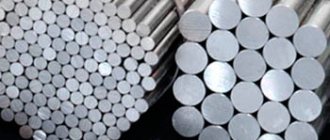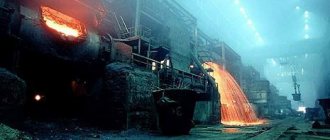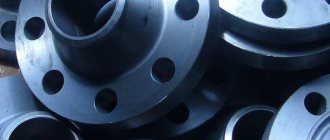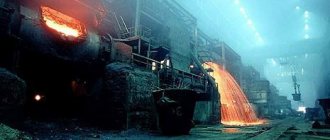Stainless steel and carbon steel are types of alloys, products from which surround us everywhere. Which one is better? It depends on the place of application. The availability of steel makes it an ideal material for many projects. It is used almost everywhere: in construction, infrastructure, aircraft, ship, carriage, automotive, household appliances and many other areas of human activity. Stainless steel from suppliers is more expensive, but it is of higher quality, more beautiful and is not subject to corrosion. The material is used in more critical areas of construction, industrial equipment, medical instruments, home improvement items, kitchen furniture and utensils.
What are the differences?
The iron in carbon steel quickly oxidizes when the carbon comes into contact with oxygen in the air or water. Stainless steel contains additives: chromium, molybdenum and the like. They make it more resistant to oxidation; in rare cases, it succumbs to corrosion.
These steels are not interchangeable, since their properties and purposes are different. Before choosing one over another, it is important to determine what it will be used for and then compare the differences in aesthetics, properties and cost.
Metallurgical products
In metallurgy, stainless steel is also known as Corrosion resistant steel, is defined as a steel alloy with a minimum of 10.5% to 11% chromium content by weight. Stainless steels are not susceptible to corrosion, rust, or moisture like regular steel, but even though steel is called stainless, it is not fully proof that it will not rust, especially when used in low oxygen levels, high salinity, or poor environmental conditions. containment environment.stainless steel alloys depending on the use and environment where it will be used and will have to withstand all the conditions that will be exposed to it. Stainless steel is used when the properties of steel and corrosion resistance are not required. Stainless steel differs from carbon steel in the percentage of chromium it contains. Unprotected carbon steel rusts easily when exposed to air and moisture. This iron oxide film (rust) is active and accelerates the corrosion process by forming more iron oxide, and due to the dissimilar size of iron and iron oxide molecules (iron oxide is larger) they tend to flake off and fall off. Stainless steels contain enough chromium to form a passive film of chromium oxide that prevents further surface corrosion and corrosion blocks from spreading into the internal structure of the metal, and due to the similar size of the steel and the oxide molecules they are bonded very tightly and remain attached to the surface. Resistance only occurs if the chromium proportion is high enough and oxygen is present.
High oxidation resistance in air at room temperature is usually achieved with additions of at least 13% (by weight) chromium, and up to 26% if used in harsh conditions. chromium forms a passivation layer of chromium(III) oxide (Cr 2 O 3) upon contact with oxygen. The layer is too thin to be visible, but the metal remains shiny. The layer is impermeable to water and air, and protects the metal underneath. In addition, this layer quickly recovers when the surface is scratched. This phenomenon is called passivation and is observed in other metals such as aluminum and titanium. Corrosion resistance can be extremely negatively affected if the component is used in a non-oxygen environment, a typical example being underwater bolts. Just like steel, stainless steel is not a very good conductor of electricity, about a few percent of the electrical conductivity of copper. Ferritic and martensitic stainless steels have magnetic properties. Austenitic stainless steels are not magnetic.
Corrosion-resistant steels of increased strength, steel types 07Х16Н6, 09Х15Н9У, 08Х17Н5М3 are widely used in modern technology industries.
Substitutes for some steel grades:
12Х18Н10Т - 08Х18Г8Н2Т, 08Х17Т, 15Х25Т, 12Х18Н9Т; 20Х23Н18 - 20Х23Н13, 15Х25Т; 420Х13 - 0Х13.
Stainless steel's resistance to corrosion and staining, low maintenance and familiar shine make it an ideal material for many structures. There are more than 150 grades of stainless steel, of which fifteen are the most commonly used. Alloy crushed into rolls, sheets, slabs, rods, wires, pipes to be used in cookware, cutlery, household appliances, surgical instruments, large appliances, industrial equipment, and in the automotive and aerospace industries as well as alloy structure and building materials in large buildings.
Storage tanks and tankers used to transport orange juice and other food products are often made of stainless steel due to its corrosion resistance and antibacterial properties. This also benefits its use in commercial kitchens and food processing plants as it can be cleaned and steam sterilized and does not require painting like other surfaces. Stainless steel is used for jewelry and watches and does not oxidize or turn black. Some firearms include stainless steel parts. Some pistol models such as the Smith & Wesson Model 60 and Colt M1911. The gun can be made entirely of stainless steel. It appears with a high gloss finish which is similar to nickel plating. Unlike coatings, the finish is not subject to peeling, peeling, and is protected from abrasion (for example, when repeatedly drawn from a holster), or rust when scratched. Some car manufacturers use stainless steel as a decorative trim in their cars.
Stainless steel is used for buildings for practical and aesthetic reasons. Stainless steel was all the rage in the Art Deco style. The most famous example of this is the top of the Chrysler Building. Some eateries and fast food restaurants use large decorative panels and stainless steel fixtures and furniture. Due to the strength of the material, many of these buildings retain their original appearance. Stainless steel is used on the exterior of both the Petronas Twin Towers and the Jin Mao buildings, two of the world's tallest skyscrapers. The Australian Parliament in Canberra has a stainless steel flagpole weighing over 220 tonnes (240 short tons).
Recycling and Reuse Stainless steel is 100% recyclable. On average, stainless steel is made up of about 60% recycled materials, of which approximately 40% comes from the end of the product's life and about 60% comes from manufacturing processes.
According to the International Resources Group, per capita use of stainless steel products in society is 80-180 kg in more developed countries and 15 kg in less developed countries. There is a secondary market that recycles useful stainless steel scrap for many markets. The product is mainly coils, sheets and blanks. This material is purchased at less than cost and is sold to commercial quality stampers and sheet metal houses. Material may have scratches, pits and dents which are subject to current specifications.
Similar articles:
- 02/11/2012 20:52 —
Steel grade 35Х23Н7СЛ Heat-resistant steel 35Х23Н7СЛ Specialists of the Litshtamp production association offer heat-resistant alloy steel from warehouses…">Steel 35Х23Н7СЛ
- 02/11/2012 20:47 —
Steel grade 40Х24Н12СЛ Steel 40Х24Н12СЛ The production association “Litstamp” today offers high-quality steel grade 40Х…">Steel 40Х24Н12СЛ
- 02/11/2012 20:41 —
Steel grade 12Х18Н9ТЛ Steel 12Х18Н9ТЛ Among the high-quality metallurgical products, the Litstamp production association offers steel…">Steel 12Х18Н9ТЛ
- 02/11/2012 16:43 —
Steel grade 20Х25Н19С2Л Heat-resistant steel 20Х25Н19С2Л Steel grade 20Х25Н19С2Л, offered by the Litshtamp production association, is…">Steel 20Х25Н19С2Л
- 17/10/2012 11:03 —
High Speed Steel Tool Steel High speed steel is a subset of tool steels widely used in attachments and cutting tools...">High-speed steel
Next articles:
- 20/07/2012 13:32 —
Steel is an alloy of iron and other elements, the most common of which is carbon. Carbon content in steel is from 0.2% and 2.1% by weight...">Steel
- 04/24/2012 13:43 — Steel
- 09/04/2012 19:15 —
Structural alloy steels according to the degree of alloying are divided into low-alloy steels (less than 5% of alloying elements), medium alloy steels (...">Low alloy steels
- 09/04/2012 19:08 —
Structural carbon steel is a general term for varieties of a group of steels intended for the manufacture of workpieces in the form of castings, castings, ...">Non-alloy steel
- 09/04/2012 17:28 —
High alloy steels contain more than 10% alloying components. In their composition, they should not contain more than 0.045% phosphorus and sulfur taken together...">High alloy steels
Chemical composition
Carbon steel is created by combining carbon and iron. Various impurities such as sulfur, silicon, phosphorus and manganese are removed during the production process. The carbon content makes it tough and durable.
Stainless steel production follows the same steps, but chromium, nickel, nitrogen, and molybdenum are added to it. Chromium content is a key factor. It must be at least 10.5%. Chromium plays an important role in protecting the metal by creating a passive surface layer. This layer protects against rust and promotes self-healing when minor abrasions occur.
How does a steel frying pan differ from a cast iron frying pan?
Carbon content. If more than 2.14% is cast iron, less is steel. What does this tell the average user? Nothing!
Cast iron is more brittle. And less plastic. Therefore, products from it are cast of impressive thickness.
Steel is heavier. But since a steel frying pan can be made thinner, it will always weigh less than a cast iron frying pan of the same diameter.
Other differences will be below.
Properties
The materials have noticeable differences in properties. Carbon steel has magnetic properties and is divided into three main types based on carbon content: high carbon, medium carbon and low carbon. It has high thermal conductivity and distributes heat well.
Stainless steel is generally non-magnetic, with a few exceptions. It has high strengthening properties, which makes it less malleable. Has low thermal conductivity and heat distribution. There are about sixty grades of stainless steel, depending on their degree of magnetism, percentage of chromium and proportions of other elements.
General characteristics
Carbon steel is divided into 3 groups according to the requirements for chemical composition and mechanical properties. Letter designation. The defining factors for the group are:
- A - mechanical properties;
- B - chemical composition;
- B - the chemical composition and basic mechanical properties are strictly maintained.
Group B alloys are chemically tested, and a sample is taken from the ladle during a spill to check mechanical properties - tensile and flexural strength, impact strength. Hardness is controlled by heat treatment.
Coating options
Carbon steel can be improved by sanding and polishing and then coated with enamel or powder paint. This coating looks aesthetically pleasing and provides additional protection from bad weather. Powder coatings come in a variety of colors and can be used on steel and stainless steel surfaces, although they are more often applied to carbon steel. They not only protect, but also add other benefits. Powder coated products match the colors of nearby infrastructure or blend into corporate color schemes. Items can also be brightly colored to highlight and add visibility. This is especially important for items such as security bollards.
Restorative properties of stainless steel
Due to its passive layer, stainless steel requires minimal maintenance. But it can be at risk of rusting if the metal molecules on the surface are not sufficiently alloyed with chromium. However, it can withstand a greater number of negative influences over a longer period of operation. She also has unique self-healing abilities. The chromium inside stainless steel forms a self-healing oxide layer that reacts with oxygen and water. This prevents rusting even in damp environments. The higher the chromium content, the better the corrosion protection.
LiveInternetLiveInternet
There has long been debate about which is better: carbon steel or stainless steel. We offer you a short review in two parts on both types of steel. The choice is, of course, yours.
By and large, all steels are conventionally divided into carbon and stainless steel. In fact, all steel contains carbon in one way or another, so they all rust in one way or another, but to varying degrees and over different times. It is generally accepted that the so-called “Non-corrosion” properties appear in steel if it contains the alloying component chromium in an amount of at least 13%.
Carbon steel is steel that either does not contain chromium at all (as an alloying component), or its percentage is less than the cherished 13%.
All steels have their pros and cons. The disadvantages of carbon steels include the fact that these steels rust, and sometimes very quickly. In addition, rusting steel can have an unpleasant odor and also leave marks during the cutting process.
This is all, of course, unpleasant, but it’s not all bad. Carbon steels rust differently. The more carbon there is in steel, the faster it becomes covered with saffron marks. In addition, the percentage of carbon affects the sharpening process: the more carbon in the steel, the more difficult it is to sharpen. Therefore, many users prefer steels with a carbon content of 0.7-1.0%. For our brands these are u8-u10, shkh-15 and HVG.
By and large, in order for a blade made of good carbon steel not to rust, you just need to learn how to care for it: cut it, rinse it, wipe it dry, put it on a dry surface. Of course, this is not always possible. In this case, a simple corrosion protection method can be applied. To do this, you need to wash the blade with detergent, wipe it and immerse it in lemon juice for 2-3 hours. After this, the blade must be rinsed and dried thoroughly. The blade will return to its normal gray color. The oxide film that forms on the surface of the metal will prevent it from rusting further.
The advantages of carbon steels include good directionality. It can produce a thinner and at the same time stable cutting edge. Even in a dull state, such knives will cut very well. Additionally, carbon steel is said to be more resistant to low temperatures than stainless steel. Experience shows that carbon steel is an ideal option for working with wood.
This was a review of carbon steels, which include Damascus, XB5, X12MF, 9XS, U10, etc.
Stainless steels will be discussed in Part 2 of this article.
Other factors
Another consideration when choosing carbon steel or stainless steel may be the price. Stainless steel is more expensive due to the addition of various alloying elements. But it does offer the benefit of added corrosion protection and can be a worthy investment depending on the application. Of course, not all environments are created equal, and corrosion is not always a determining factor for some projects. In most cases, climatic conditions allow the use of carbon steel; it copes well with its tasks when a protective coating is applied to it.
What is carbon steel
There is carbon and carbon steel. The word “carbon” itself means only carbon and came to us from Latin through other languages. But due to direct borrowing, or rather, tracing paper, we have confusion.
Carbon is carbon fiber and has nothing to do with our frying pans.
Carbon steel is a high carbon steel. So a carbon frying pan is just a steel frying pan.










